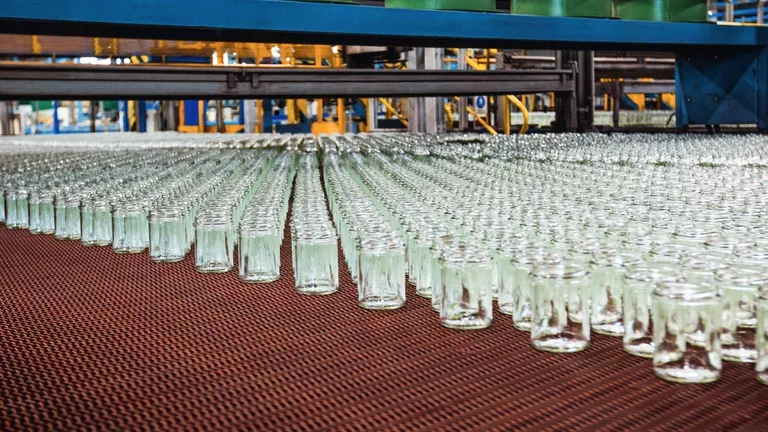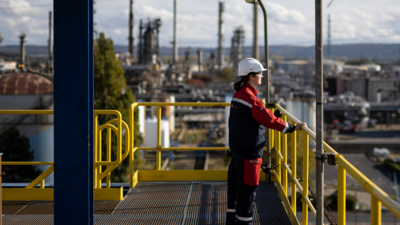Delivering the world’s glass with less gas
Published on April 20, 2023
4 minutes

Entering the meeting room at the Verallia glass plant in Pescia, Italy, the first thing one notices is all the bottles of water in the middle of the table.
Luckily, we don’t have to wait long until our host, Andrea Cendron, Technical Director at Verallia Italy, gestures toward them: “Please, help yourselves,” he says, adding with a chuckle, “We’re not running short.”
That’s certainly true: with 34 plants producing more than 16 billion glass containers every year, Verallia is the world’s third largest manufacturer of bottles and jars for beverages and foodstuffs. And after the tour – especially the brief stop by the furnace – we’re thirsty.
“Glass is made by melting a mixture of silica, contained in sand, or indeed recycled glass – and this requires temperatures of around 1,500°C,” Andrea explains. By way of comparison, gold melts at just over 1,000°C; lead is already liquid at 300°C. “Our production process is highly energy intensive, so our main challenge is to lower our carbon emissions.”

“Our new-generation on-site oxygen production unit is more efficient than current systems. It lowers both energy consumption and related carbon emissions.
”
Benjamin Coiffier
On-Site Innovation Program Manager, Industrial Merchant activity at Air Liquide
“This is where Air Liquide can help,” says Alessandro Pallotti, Key Account and Business Development Manager at Air Liquide Italy. “In late 2021, Verallia announced ambitious sustainability objectives, and we were able to respond with a proposal specifically tailored to the glass market. Here in Pescia, we will be combining our new next-generation, on-site oxygen production unit, which will be 10% more energy efficient than the previous generation, with our HeatOxTM technology, which will recover wasted heat from furnaces to save up to 20% of the energy needed for the glass melting process. The result: an 18% reduction in CO2 emissions. The solution will also deliver an up to 90% reduction in nitric oxide emissions, which in high concentrations can be harmful to health.”
He continues, “Now, separating oxygen from air also requires energy, but our new on-site oxygen production units are more efficient than current systems, which lowers both our energy consumption and related carbon emissions; they also produce purer oxygen, further reducing nitric oxide emissions.”

“We will be combining our new-generation, on-site oxygen production unit with our HeatOxTM heat recovery system to deliver energy savings of up to 20%.
”
Alessandro Pallotti
Key Account and Business Development Manager at Air Liquide Italy
“Then, there is HeatOxTM, our proprietary technology that harnesses the high-temperature fumes emitted by the furnace to preheat the natural gas and oxygen fed into it. They must be at about 500°C on entering the furnace. Thanks to heat recovery, less energy is needed to bring them up to temperature,” Alessandro further explains.
According to Andrea, these technologies are real game changers: “By introducing pure oxygen as an oxidizer in our production process, and using HeatOxTM to recover the flue gas heat, we will vastly improve our performance regarding specific emissions compared to a conventional furnace.” Air Liquide’s twin oxy-combustion and heat recuperator solution is scheduled to go into service in Pescia at the beginning of January 2024, and preparations are already well underway.
“For us as glass producers, long-term planning and continuity of supply are absolutely essential,” explains Andrea. “Once we commission a new furnace, it will be in continuous operation – day and night – for its entire service life, which is around 15 years. If we ever had to switch it off, recommissioning would be difficult.”
“We have built up strong working relationships at all levels,” says Andrea, “and we know that Air Liquide is a trusted partner with whom we can explore future solutions to our challenge of reducing our emissions.” Air Liquide’s support of Verallia’s sustainability goals in Italy is only the beginning. In Brazil, too, the Group is working with Verallia to upgrade its furnaces. As an important step toward making glass manufacturing carbon neutral, Air Liquide has completed preliminary tests with another partner to replace natural gas with hydrogen. “But before we start talking about H2,” Andrea jokes, “can I offer anyone some more H2O?”

“We know that Air Liquide is a trusted partner with whom we can explore future solutions to our challenge of reducing our emissions.
”
Andrea Cendron
Technical Director at Verallia Italy

